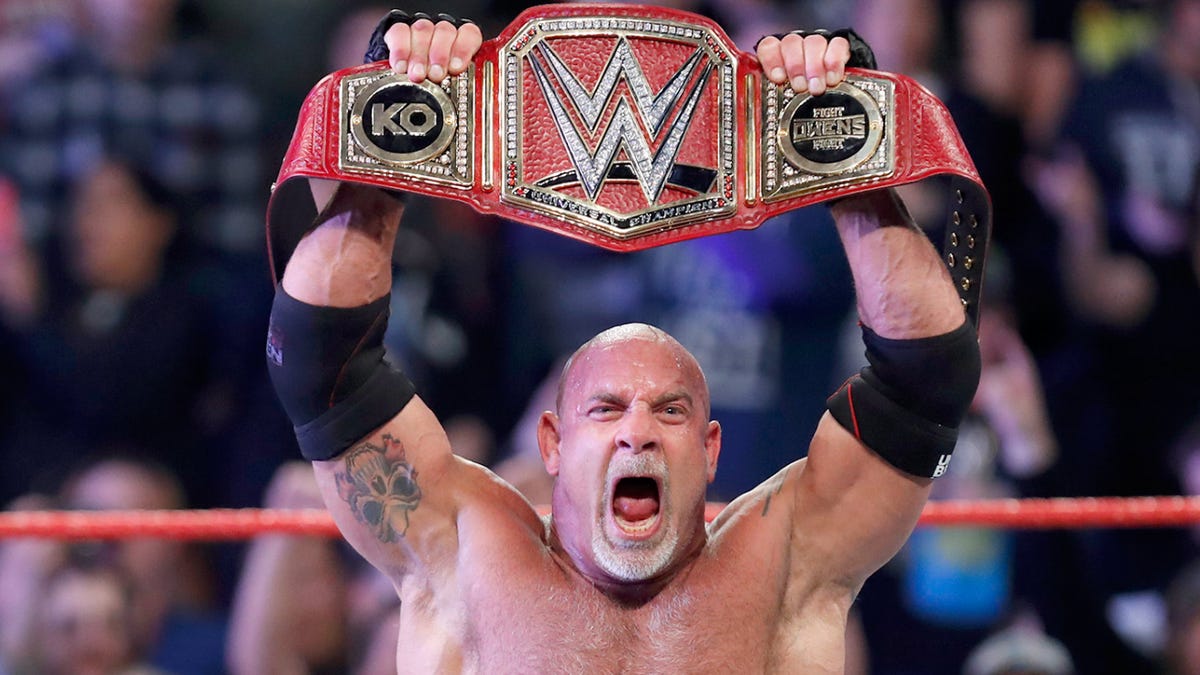WWE wrestles with its past as 90s star Bill Goldberg rises again
Commentary: The biggest pro wrestler of 1998 is once again king of the mountain. Is it good business, or is the WWE jeopardizing its future?

The Rock, Hulk Hogan and "Stone Cold" Steve Austin are all household names, but for a brief period in the late '90s there was a wrestler just as popular as any of them: Bill Goldberg.
At Sunday's Fastlane event, a 50-year-old Goldberg once again became the top man in the business when he bested Kevin Owens to win the WWE Universal Championship.
Next month's WrestleMania 33, airing on the WWE Network, is the company's biggest show of the year. It'll be headlined by Goldberg as he defends his newly won title against Brock Lesnar.
13 years after his retirement in 2004, Goldberg is once again The Man. But at what cost?
Part-time problem
For the last five years, there's been an ongoing argument within the wrestling business.
Does it make sense for part-time stars, such as The Rock, Triple H and Brock Lesnar, who only show up a few times a year, to take part in marquee WrestleMania matches?
These icons often have a quantifiable impact on ratings and intrigue casual fans. But at the same time, they take opportunities away from younger wrestlers, who get relegated to background roles while the spotlight shines on returning performers.
Last year, Triple H, 47, wrestled Roman Reigns in the main event of WrestleMania 32, but hasn't wrestled since. The Undertaker, 51, has made one brief in-ring appearance since WrestleMania, entering last month's Royal Rumble. Both veterans are expected to be major parts of Wrestlemania 33 on April 2.
When these returning all-stars are positioned so strongly, it can give the impression that full-time performers such as Dean Ambrose and Kevin Owens are just the B team. That may lead to dips in day-to-day business, if the WWE isn't careful.
In 2012, The Rock faced John Cena in the main event of WrestleMania 28. Since then, no WrestleMania main event has consisted entirely of full-time WWE performers.
But no one can claim the formula doesn't work. WrestleMania 29, headlined by The Rock and John Cena's return match, was touted as the company's highest grossing event, making the WWE $72 million. WrestleMania 31, featuring Brock Lesnar in the main event, drew a record $12.6 million in ticket sales alone. Last year, around 100,000 people packed Dallas, Texas' AT&T Stadium to see Triple H take on Roman Reigns.
These big WrestleMania matches also lead to big boosts in WWE Network subscribers. In 2015, WWE gained 511,000 new paid subscribers to the Network during WrestleMania season, and another 140,000 the year after, according to The Wrestling Observer.
But there is a downside: Last year, 358,000 signed up for a free month (like Netflix, you'll get the first month for free) but opted to not stay on after WrestleMania. Much of this could be chalked up to freeloaders, but the big stars leaving after WrestleMania could certainly be a factor.
WWE has a conundrum here, and Goldberg vs Brock Lesnar encapsulates it perfectly.
Big time
When Goldberg returned to the WWE last October, he was originally scheduled for one big match against Brock Lesnar at Survivor Series in November, according to The Wrestling Observer. But his return caused a huge buzz, and a big bump in WWE ratings, making the company change its plans. Goldberg signed a contract to wrestle a few more matches, culminating in next month's WrestleMania main event.
If this isn't Goldberg's last match, it's not far off it: He's 50 years old and originally thought he was wrestling one match so his son could see him perform. Meanwhile, Lesnar, arguably WWE's biggest star, wrestles around five times a year. To set up their match at WrestleMania, this past weekend Goldberg beat the now former-champion Kevin Owens, a full-time star you can see every week on Monday Night Raw, in just over 20 seconds.
This rubbed some fans the wrong way, especially brevity of the match. In recent years, fans have become accustomed to longer, more hard-fought main events. Goldberg's two one-on-one matches since returning have lasted a combined 1 minute and 48 seconds.
The company wrote his bouts this way to make him look as dominating as possible, but it's led some to question how exciting their 'Mania bout will be. Most main events last around 20 minutes, so you can understand how some could find a 20-second match a little flat.
It's a polarising issue among wrestling fans, to say the least.
No matter who wins, a part time star will walk out of WrestleMania 33 as the WWE Universal Champion.
While that's sure to upset some fans, the show will pull around 60,000 people into Orlando, Florida's Camping World Stadium, and bring even more to the WWE Network for Wrestlemania where it'll be streamed live to subscribers.
Come WrestleMania season, the WWE is all about getting as much viewers and media attention as possible. It has records to break, and it'll break them by any means -- whether that means using stars that work five nights a week or five times a year.

